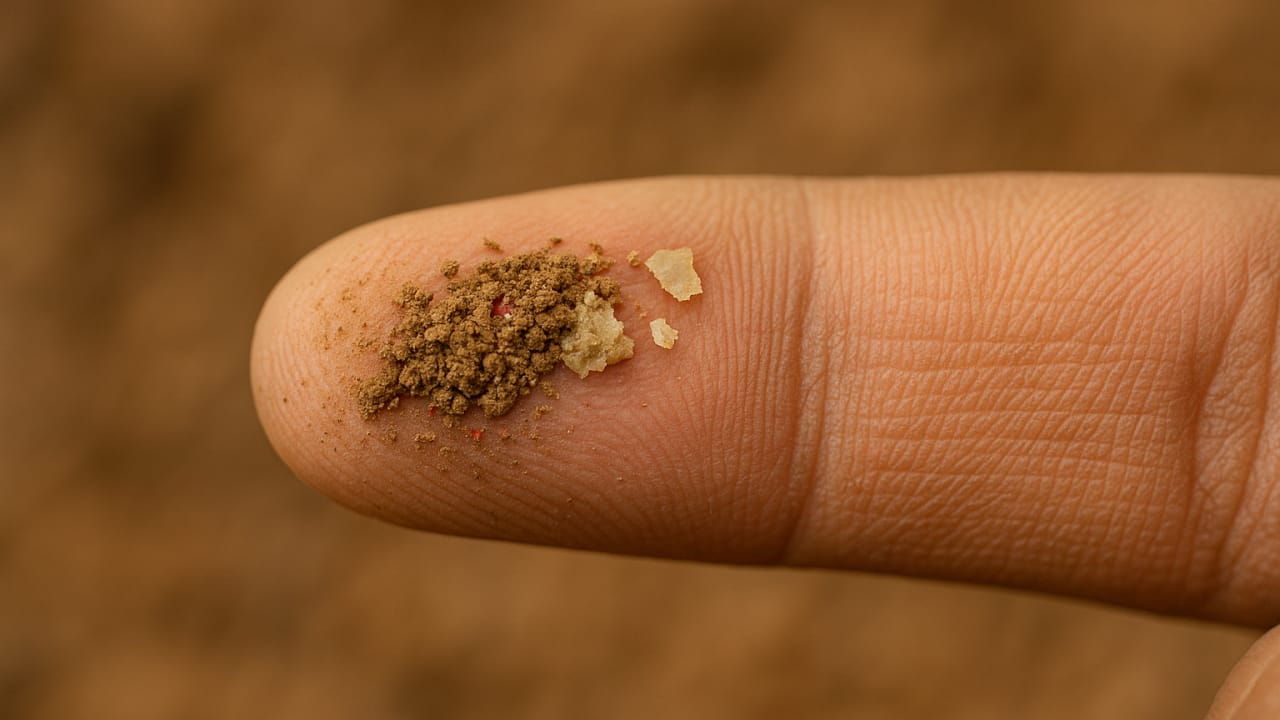The Field That Bled Plastic

bySantosh Nagasamy
I was a farmer. I’ve seen what we’ve done to our soil. Now I can’t unsee it.
Mahabaleshwar, 6:04 a.m. The air is crisp. The soil is not. Raju, a second-generation strawberry farmer, crouches over a raised bed, tugging at a sheet of black plastic mulch that’s embedded itself into the land. It peels off in shredded strips, splintering like burnt paper. “We get what we can,” he says. “But the rest? It just stays.”
I nod. I’ve seen this before. Before I became a CEO, before Phitons, before Singapore—I was a farmer too. For three years, I lived in a modest shelter on my farm, working the land day in and day out.
That land taught me many things. But the lesson I carry with me every day is this: we are suffocating our soil. And most people have no idea.
The Plastic We Don’t Talk About
Plastic mulch was supposed to be a miracle. It promised higher yields, better moisture retention, weed suppression, and easier farm management. And in the beginning—it delivered. But no one asked the harder questions:
- What happens after it’s removed?
- What if it’s never fully removed?
- What does the soil look like ten years in?
I’ve seen the answers firsthand. In the beginning, it was just visible pieces. Then they became smaller. Slivers. Specks. Dust. The plastic never left. It simply became invisible—while still very much present.
And because the consequences aren’t immediate, we carry on. We forget that soil is not infinite. We treat it as if it will always recover, always forgive. But every season takes more than it gives back.
The Recycling Illusion
India often quotes a plastic recycling rate of ~42%, but that figure is misleading. It includes durable plastics, PET bottles, and industrial scrap. It does not reflect agricultural plastics like mulch film.
In reality:
- Mulch films are rarely collected.
- By the time they’re pulled, they’re coated with 30–80% dirt and debris.
- Less than 1% ever sees a formal recycler.
The rest? Burned. Buried. Forgotten. Or worse—left to break into microplastics that leach into the soil and stay there.
What Happens to the Soil?
Long-term studies now show up to 260 kg of residual plastic per hectare after a decade of mulch use. But that’s just the start.
Mulch films often contain:
- Stabilisers (to resist UV)
- Plasticisers (to stay flexible)
- Colorants and pigments (for heat control)
- Chemical residues (from fertilisers and sprays that bind to plastic shards)
These chemicals don’t just sit there. They alter soil structure. They disrupt microbial communities. They reduce water retention and nutrient exchange. They make the earth itself hydrophobic—literally repelling the water it once held.
And once soil begins to fail, we do what we’ve been trained to do: we apply more chemicals.
The Chain Reaction We Choose to Ignore
As fertility drops, farmers are forced to use more chemical fertilizers just to maintain yields. But studies show crops absorb only about 50% of what’s applied. The rest doesn’t stay on the field.
It leaches.
Into the groundwater. Into the rivers. And finally, into the oceans—where it fuels algal blooms that suffocate marine life, create vast dead zones, and wreak havoc on entire ecosystems.
The Gulf of Mexico. The Bay of Bengal. The Arabian Sea. What started as a plastic sheet on a farm ends in the collapse of marine food chains.
What happens in the soil does not stay in the soil.
“It’s Just Some Soil in Some Farm Somewhere.”
That’s what many people think. “How is it my problem?”
But here's the truth: it’s everyone’s problem.
When soil breaks down, more chemicals are used. Those chemicals don’t stay in the field. They leach into groundwater, run into rivers, and end up in oceans. That seafood you ate last week? That water your child drank? That’s where it lands.
What starts as plastic in a strawberry field becomes toxins in a fish, fertilizer in a drinking well, or algae choking a coastline thousands of kilometers away. thousands of kilometers away. thousands of kilometers away.
We’re all downstream.
We’ve fooled ourselves into thinking that environmental problems are isolated. That someone else, somewhere else, will deal with them. But that’s not how systems work.
The earth is not divided the way our minds are.
And Still—Most People Don’t Care
That’s the part that stays with me. People don’t care—not because they’re cruel, but because the damage takes time. A decade here. A few failed crops there. By the time the land is no longer viable, the people who made the decisions have moved on. New land. Same script. Different victims.
This is not just environmental neglect. This is a business model. One built on short-term yield and long-term amnesia.
So What Can We Do?
We need systemic change. We need regenerative practices. We need long-term thinking.
But we also need to start somewhere.
And at Phitons, we’re starting with mulch.
We’ve spent the last three years building a naturally compostable mulch that breaks down safely and even enriches the soil it once covered. Top seed producers have already put it through real-world trials—and attested to its performance.
We’re not offering a silver bullet. We’re offering a better question:
What if farming didn’t come with a landfill surcharge?
Because the Soil Remembers
I’ve walked fields that no longer breathe. I’ve seen soil that repels water. I’ve seen roots twisted around plastic that should never have been there in the first place.
And I know this much: If we don’t change the story, our children will farm in poison—or not at all.
We are done burying plastic. The next harvest will bury the thinking that created it.
🔁 If this made you pause, share it. 🟢 If you care about where your food comes from, follow Phitons. 💬 If you’ve seen this too, speak up.
True change doesn’t start in policy rooms or pitch decks. It starts with the ground beneath our feet.

